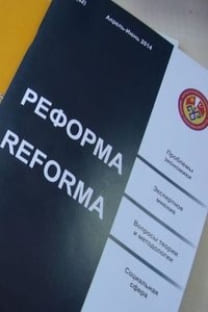THE EFFECT OF EXCHANGE RATE VOLATILITY ON MONEY SUPPLY IN KYRGYZSTAN
exchange rate, money supply, international reserves
THE EFFECT OF EXCHANGE RATE VOLATILITY ON MONEY SUPPLY IN KYRGYZSTAN
exchange rate, money supply, international reserves,
___
- Afzal, M. (2010). “Exchange Rate and Reserves in Asian Countries: Causality Test”. Global Economic Review 39:2, p. 215-223. DOI: 10.1080/1226508X.2010.483839
- Calvo, G. ve Reinhart, C. M. (1999). “When capital inflows come to a sudden stop: consequences and policy options”, in: P. Kenen and A. Swoboda (Eds.) Key Issues in Reform of the International Monetary and Financial System (Washington, DC: International Monetary Fund).
- Cote, A. (1994). “Exchange Rate Volatility and Trade”, Working Paper No. 95-5 (Ottawa, Ontario: Bank of Canada).
- Gartner, M. (1987). “Intervention Policy under Floating Exchange Rates: An Analysis of the Swiss Case”. Economica, p. 439-53.
- Gerni, C., Sarı, S., Özdemir, D., Emsen, Ö.S. (2013). “Döviz Kuru Oynaklığı, Rezerv Oynaklığı ve Reel Faiz Oranlarının Dış Ticaret Üzerindeki Etkileri: Geçiş Ekonomileri Üzerine Uygulamalar”. Proceedings book of International Conference on Eurasian Economies, s. 412-419.
- Hussain, I. (2002). “Why reserves”, The Daily Dawn, August.
- Hviding, K., Nowak, M. ve Ricci, L. A. (2004). “Can Higher Reserves Help Reduce Exchange Rate Volatility? An Empirical Investigation”, Luiss Lab of European Economics Working Document No. 13 (Rome: Luiss Lab of European Economics).
- IMF, Annual Report 2014.
- Mastropasqua, C., Micossi, S. ve Rinaldi, R. (1988). “Interventions, Sterilization and Monetary Policy in European Monetary System Countries, 1979-1987,” in The European Monetary System: Proceedings of a Conference Organised by the Banca d’ Italia, STEP, and CEPR, Francesco Giavazzi, Stefano Micossi, and Marcus Miller, eds., Cambridge University Press, p. 252-87.
- Narayan, P.K. (2005). “The Saving and Investment Nexus for China: Evidence from Cointegration Tests”. Applied Economics 37(17), p. 1979-1990.
- Neely, C.J. (2000). “Are Changes in Foreign Exchange Reserves Well Correlated with Official Intervention?” Federal Reserve Bank Of St. Louis. 82(5), p. 17-31.
- Obstfeld, M. (1983). “Exchange Rates, Inflation, and the Sterilization Problem: Germany, 1975-1981” European Economic Review March/April, p. 161-189.
- Ozturk, I. (2006). “Exchange Rate Volatility and Trade: A Literature Survey”. International Journal of Applied Econometrics and Quantitative Studies 3-1, p. 85-102.
- Pesaran, H.M. ve Shin, Y. (1995). “Autoregressive Distributed Lag Modelling Approach to Cointegration Analysis”. DAE Working Paper Series No. 9514. Cambridge: Department of Applied Economics, University of Cambridge.
- Pesaran, H.M. ve Shin, Y. (1999). “Autoregressive Distributed Lag Modelling Approach to Cointegration Analysis”. Econometrics and Economic Theory in the 20th Century: The Ragnar Frisch Centennial Symposium. Cambridge: Cambridge University Press.
- Pesaran, H.M., Shin, Y., Smith, R.J. (2001). “Bounds Testing Approaches to the Analysis of Level Relationships”. Journal of Applied Econometrics 16, p. 289-326.
- Rogoff, K. ve Reinhart, C. (2002). “FDI to Africa: The Role of Price Stability and Currency Instability”, IMF Working Paper (Washington, DC: IMF).
- Taylor, D. (1982). “Official Intervention in the Foreign Exchange Market, or, Bet Against the Central Bank”. Journal of Political Economy April, p. 356-68.
- ISSN: 1694-5158
- Yayın Aralığı: Yılda 2 Sayı
- Başlangıç: 1999
- Yayıncı: Kırgızistan Türkiye Manas Üniversitesi
DESTINASYON TANITIMINDA YEREL YÖNETIMLERIN ROLÜ: BELEDIYELERIN WEB SITELERI ÜZERINE BIR ARAŞTIRMA
HEAT SUPPLY OF THE KYRGYZ REPUBLIC: PROBLEMS AND DEVELOPMENT PROSPECTS
Mirlan DUİSHENBAEV, Anna ARKHANGELSKAYA
ANALYSIS OF THE AVAILABILITY OF FINANCIAL RESOURCES IN THE HEALTH SECTOR OF THE KYRGYZ REPUBLIC
REGIONAL DEVELOPMENT AND SOCIAL-ECONOMIC SUSTAINABILITY TO THE RISKS
THE EFFECT OF EXCHANGE RATE VOLATILITY ON MONEY SUPPLY IN KYRGYZSTAN
Junus GANİEV, Damira BAİGONUSHOVA
INVESTMENT OPPORTUNITIES IN KAZAKHSTAN
Nurilya KUCHUKOVA, Kulshariya SHAYAKHMETOVA, Nazira TİULİUNDİEVA
THE SOCIO-ECONOMIC IMPORTANSE OF THE MODERN SCIENTIFIC AND TECHNOLOGICAL REVOLUTION
ECONOMIC EVALUATION OF ENERGY COMPANIES OF THE KYRGYZ REPUBLIC
